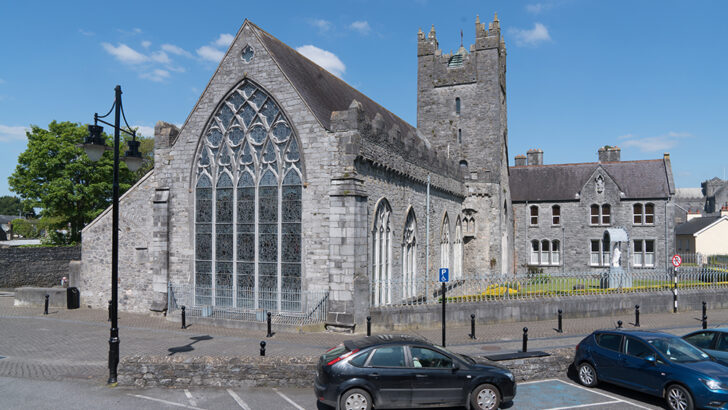What has Krakow, Vienna and Kilkenny in common?
To the best of my knowledge, these are the only three Dominican foundations of the thirteenth century north of the Alps, still occupied by Dominicans today.
In 1225 William Marshal the Younger gave to the newly arrived Dominicans to Kilkenny, a fortified tower, still perfectly preserved. Adjoining it the friars built their church, the Black Abbey, which, restored from its ruins in the nineteenth century, remains one of the architectural treasures of Ireland today.
From at least 1405-1516 the mayor of Kilkenny was elected in the chapter room each September 29. It is said that Cromwell himself may have stayed in the fortified tower when he took Kilkenny in 1650.
In 1540, with the suppression of the monasteries by order of Henry VIII, the Black Abbey became a court house it was taken for granted that that was the end of the abbey as a centre of worship. For a short period with the death of Elizabeth I in 1603 the building was claimed back and functioned as a church.
From 1642 to 1649, the time of the Confederation of Irish Catholics the Black Abbey again became a place of Catholic life and worship. At the provincial chapter held in the Black Abbey in 1643 it was agreed to establish at Galway the first monastery of Dominican nuns in Ireland, this marked the beginning of the stories of our Dominican sisters in Ireland, still vibrant to this day.
On December 19 1646 the papal legate Rinuccini ordained a number of priests in the Black Abbey, encouraging his fellow bishops to come out of hiding and to begin the public celebrations of the sacraments, especially priestly ordinations, a sign of hope for the Church in Ireland.
During the next 100 years the abbey fell into ruin. In 1776, Fr Michael Vincent Meade OP, working as curate of St Canice’s parish in the city, became tenant of the ruins of the medieval Dominican priory. It is written that “Fr Meade then put his mind to the building of a convent. Not having either a site or the necessary stone, he found both by simply demolishing the thirteenth-century choir and putting up a two-storey house in its stead”.
In 1788, another Dominican, Laurence Shaw, restored again by vandalising, lopping off the top storeys of the Norman tower and used the stones to rehabilitate the transept of the church as a chapel. But Fr Shaw left the city in 1800, with the chapel unopened. On February 9 1816, Fr John Gavin OP celebrated Mass in the Black Abbey for the first time since the arrival of Cromwell, 136 years earlier.
Little by little, with halting steps, the abbey rose up again throughout the nineteenth century, until on May 22 1864 Solemn Mass was sung for the opening of the church’s restored nave to public worship on the newly consecrated high altar.
Marking 800 years of the Black Abbey this jubilee year of hope the abbey can be a beacon for what it means for us as pilgrims of hope. The building is not a monument to the past but a testimony to the hope of past generations which we need for the present and going into the future. Like those who have gone before us we must learn to use the stones of the past, the lessons we have learned to build anew.
**
Two loves in my heart
At the recent funeral of the late president Jimmy Carter of the USA, one senator during his eulogy reminded his audience of a story Jimmy had told back in 2018. Mr Carter was telling of a time when as a young man he was a missionary in Massachusetts under the auspices of the Southern Baptist Union. One preacher particularly impressed Jimmy with his ability to win souls for Christ.
Jimmy asked him the secret of his success. The man somewhat embarrassed said; “I try to have two loves in my heart, one is for God and the other love I have in my heart is for the person who happens to be in front of me at any particular moment”.
***
Is she necessary?
Four weeks after the new baby arrived home her older sister of four years old asked her dad, “Daddy, do you think she is really necessary?”


 The Black Abbey of Kilkenny. Photo: William Murphy/infomatique
The Black Abbey of Kilkenny. Photo: William Murphy/infomatique 